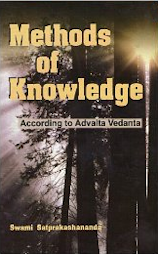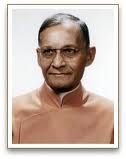Neither perception nor inference can determine the true nature of the self, which has a dual aspect—the changeful and the changeless, the empirical and the transcendental. The one is apparent, the other is real. It is the reflected empirical self identified with the body and the mind and characterized as the doer and experiencer that is perceived by the senses as an individual, but not the real transcendental self, the unchanging witness of the ever-changing body and the mind. Indeed, the sense-organs are not meant for Self-knowledge. They are created with outgoing tendencies; so a person perceives through them only external objects and not the Self within.43 'The eye does not go thither, nor speech, nor the mind."44 Being the knower per se, the inmost Self cannot be an object of knowledge. So the Sruti points to It as the immutable witness (sAkShI, draShTA) of the physical and the psychical events: 'You cannot see that which is the witness of vision; you cannot hear that which is the hearer of hearing; you cannot think that which is the thinker of thought; you cannot know that which is the knower of knowledge. This is your Self that is within all; everything else but that is perishable.'45 Such means of knowledge, as perception and the rest based on it, deal only with the knowables and not with the Self, the knower per se.46 The Knower is contrary to all that is known including the body and the mind. While the known are many, limited, changeful, and non-conscious, the knower is one, unlimited, changeless, and self-aware. So says sureShvara: 'The inmost Self, which is perpetual awareness, which is not dependent on any other proof [being self-evident], which is without attributes, such as sound, form, etc., as to whose existence there is no room for doubt, which is supreme blessedness, which is immeasurable, which is the innermost being, cannot be determined by such means of knowledge as perception and the rest engendered by despicable desire.'47 Man's inmost Self is self-manifest. Being of the nature of Pure Consciousness, it shines of itself, so to speak. Therefore, each and every individual is spontaneously aware of his own existence. No process of knowledge is involved in his self-awareness. It is immediate and direct presentation (sAkShAt aparokShAt). Self-awareness is the central fact from which all thoughts, all cognitions, and all actions of an individual proceed. Before he thinks, or sees, or acts he knows that he is. It is not inferential knowledge. The luminous self is prior to all mental operations. One does not deduce one's existence from them. It is self-evident, being of the nature of consciousness. The point is, 'I am, therefore I think', and not 'I think, therefore I am', as Descartes said. But the great French philosopher did not mean the dictum cogito, ergo sum as an inference, but as an axiomatic truth, which is perceived immediately prior to cogitation.48 None needs proof of his own existence. A man is sure of his existence before he is sure of anything else. He invariably accepts this as the established fact, and makes it the nucleus of all other facts. The self is self-revealing. It is authority by itself. Each and every form of existence presupposes the conscious self. The first thing real to an individual is his own self. On the basis of this he accepts, or denies, or doubts whatever he does. A man can disavow anything, even God, but not his self. In repudiating the self he has to acknowledge it as the repudiator. So says Sankara, 'Being the basis of all proof and disproof, the self is established prior to them. It is not possible to deny an entity of this nature. What is extraneous can be denied, but not the self. For, he who denies that is the self.'49 Though aware of his own existence, man is not aware of his real nature. He is vaguely conscious of the fact that he does not know himself as he is. Sometime or other he likes to ponder on such questions as 'Who am I?' 'Where am I from?' 'Whither am I to go?' It is with reference to man's real nature that Socrates gave the instruction, 'Man, know thyself. It is enigmatic that man with all his pretensions to knowledge does not know himself. Nay, he knows himself wrongly. He identifies himself more or less with anything other than the self, such as the body, the senses, the mind, the vital principle, the kindreds, and even with the pets and possessions. All his miseries are due to this wrong knowledge, the root cause of which is aj~nAna (antiknowledge).50 He attains supreme blessedness through Self-knowledge on the removal of the veil of aj~nAna. 'Know yourself and you shall then know God', says Sri Ramakrsna.51 Though veiled by aj~nAna (antiknowledge), man's inmost self shines as its witness (sAkShI) and is unaffected by it. It is the light that manifests darkness. The sun manifests the cloud that hides it. A person can be aware of his ignorance regarding the real nature of the self by introspection. During deep sleep when all mental operations cease, the self beyond the ego stays as the witness of unspecified ignorance (aj~nAna) that engulfs the mind. The luminous self has no sleep, being its witness. The psychophysical adjunct of an embodied soul is rooted in aj~nAna, which forms his causal body. Just as the resplendent sun being reflected in a water-surface partakes of some of its qualities and appears to be different, similarly, the effulgent self, being associated with the psychophysical adjunct through its reflection in aj~nAna functions as the experiencer and as the doer without losing its transcendental character as the unchanging witness. While aware of himself as the knower, the reflected self gets identified with the known, such as the body, the senses, the vital principle, and the mind, and ascribes to himself what actually belongs to them. Being subject to aj~nAna, not only does he fail to apprehend his real nature as Pure Consciousness, but even misapprehends himself as other than what he is. The purpose of the Sruti is to eliminate all contrary notions of an individual regarding the self, with their root-cause aj~nAna. The realization of the self does not mean the attainment of something unattained. It is the recognition of the self on the removal of the veil of aj~nAna. Self-knowledge does not mean knowing an unknown object, but the manifestation of the knower free from all superimposition. So says sureShvara, 'Just the removal of aj~nAna is regarded as the whole result of the Vedic testimony and not the knowledge of something unknown, which is absurd in the case of Atman that is awareness itself'.52 The embodied soul is apparently changeful but really changeless, apparently impure but really pure, apparently mortal but really immortal, apparently bound but really free. The various names and forms and states that characterize an individual actually belong to the limiting adjuncts constituting his three bodies—the gross, the subtle, and the causal—but are falsely ascribed to the indwelling self. Throughout the varying conditions, physical and psychical, that he undergoes as the experiencer and doer, the inmost self (pratyak AtmA) ever shines as their witness distinct from them. Thus, the indwelling self has two main aspects: As subject to the limiting adjuncts it is the experiencer and doer; as their transcendent witness it is immutable Pure Consciousness. Underlying all mental operations and their intervals, the witness, 'sAkShI', is ever present as their illuminator. Being perpetually the same despite all variations of the psychophysical adjunct, this is also called 'kUTastha' (lit. firm as an anvil). As stated in the pa~nchadashI, 'It is the immutable self (kUTastha) that has been defined by the foregoing teachers everywhere as the witness of the mind (antaHkaraNa) and its modes and in many otherways'.53 43 Vide Ka. U. II: 1.1. |
|||
|
|||


www.advaita.org.uk
Advaita for the 21st Century



Book Extract
The Sruti as a means to the knowledge of the Self
Swami Satprakashananda

Swami Satprakashananda (1888 - 1979) met Swami Vivekananda in 1901 and was involved in establishing the Ramakrishna Math and Mission at Dhaka, joining the order in 1924. He moved to the USA in 1937, establishing the Vedanta Society of St. Louis, remaining in charge until his death.
Website: http://www.vedantastl.org/
Biography
BOOK DETAILS
Publisher:Advaita Ashrama
ISBN: 978-8175050655
Format : Hardback
Pages: 366
List Price: £14.50 (2nd hand), US$42.50
(Out of Print)
Where to Buy
AUTHOR DETAILS

